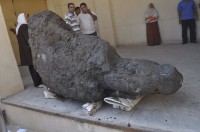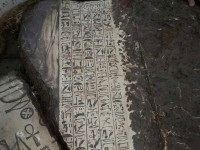 The remains of a 3,400-year-old temple from the reign of Tuthmose III (1479-1425 B.C.) have been found underneath a house in the Egyptian town of Badrashin 25 miles south of Cairo. It was discovered two weeks ago under shady circumstances. A group of seven men dug nearly 30 feet (nine meters) under their home, even going so far as to secure wet suits, oxygen tanks and diving masks so they could keep digging after they hit the water table. The Tourism and Antiquities Police heard about the clandestine dig and arrested the men for illegal excavation. They were detained briefly but had to be released because the area where they were digging was not a designated archaeological site.
The remains of a 3,400-year-old temple from the reign of Tuthmose III (1479-1425 B.C.) have been found underneath a house in the Egyptian town of Badrashin 25 miles south of Cairo. It was discovered two weeks ago under shady circumstances. A group of seven men dug nearly 30 feet (nine meters) under their home, even going so far as to secure wet suits, oxygen tanks and diving masks so they could keep digging after they hit the water table. The Tourism and Antiquities Police heard about the clandestine dig and arrested the men for illegal excavation. They were detained briefly but had to be released because the area where they were digging was not a designated archaeological site.
 It is now. The entire Hod Zeleikha neighborhood has been declared an archeological site and is now under the control of the Antiquities Ministry. The unauthorized amateur excavation has been replaced with an official dig by archaeologists from Egypt’s antiquities ministry and workers from the state-owned Arab Contractors Company. After pumping out the groundwater, the team discovered seven large limestone blocks engraved with hieroglyphic inscriptions, the bases of several columns and a piece of a colossal statue. The colossus fragment is 6.2 feet high and carved out of pink granite. It depicts a seated person.
It is now. The entire Hod Zeleikha neighborhood has been declared an archeological site and is now under the control of the Antiquities Ministry. The unauthorized amateur excavation has been replaced with an official dig by archaeologists from Egypt’s antiquities ministry and workers from the state-owned Arab Contractors Company. After pumping out the groundwater, the team discovered seven large limestone blocks engraved with hieroglyphic inscriptions, the bases of several columns and a piece of a colossal statue. The colossus fragment is 6.2 feet high and carved out of pink granite. It depicts a seated person.
 The hieroglyphics date the structure to the New Kingdom period (1539-1075 B.C.) and at least some of the inscriptions date to the reign of the pharaoh Tuthmose III (1490-1436 B.C.). The reign of Tuthmose III is considered a golden age in Egyptian history. The stepson and nephew of pharaoh Hatshepsut, Tuthmose III was technically pharaoh from the age of two, co-ruler with his stepmother. In practise he didn’t rule until Hatshepsut died 22 years after they ascended to the throne. He ruled another 32 years after Hatshepsut’s death. Under his reign, the Egypt empire reached its greatest extent, from northern Syria to the Fourth Cataract of the Nile in Nubia.
The hieroglyphics date the structure to the New Kingdom period (1539-1075 B.C.) and at least some of the inscriptions date to the reign of the pharaoh Tuthmose III (1490-1436 B.C.). The reign of Tuthmose III is considered a golden age in Egyptian history. The stepson and nephew of pharaoh Hatshepsut, Tuthmose III was technically pharaoh from the age of two, co-ruler with his stepmother. In practise he didn’t rule until Hatshepsut died 22 years after they ascended to the throne. He ruled another 32 years after Hatshepsut’s death. Under his reign, the Egypt empire reached its greatest extent, from northern Syria to the Fourth Cataract of the Nile in Nubia.
The recovered artifacts have been transported to Saqqara for conservation and study. Archaeologists hope the inscriptions and future discoveries will reveal more about the history of Egypt under Tuthmose III. The ministry plans to continue the archaeological survey of the site and excavate more of the temple.